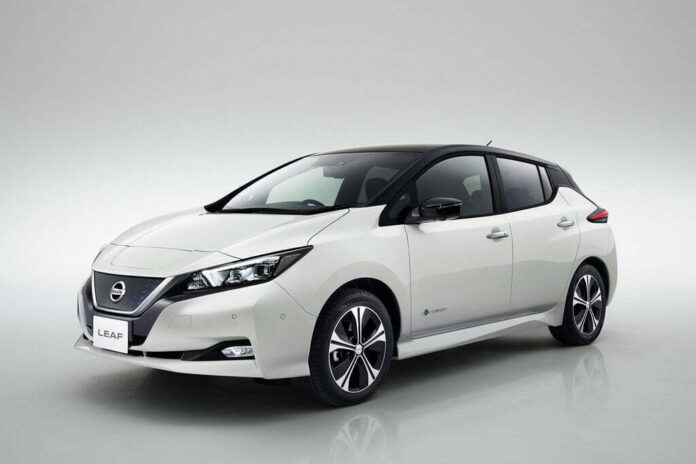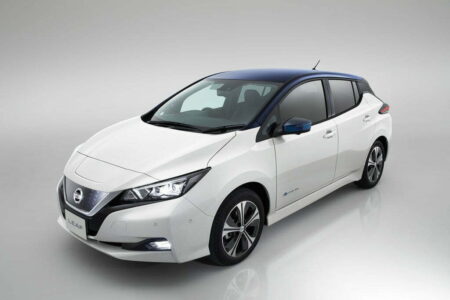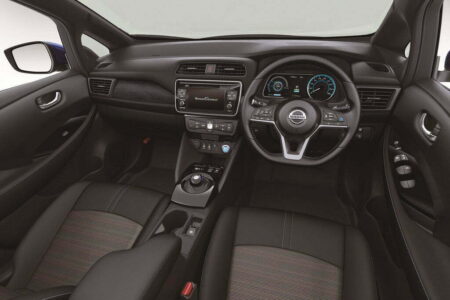The new Nissan LEAF is offering customers greater range, advanced technologies* and a dynamic new design to stay in time with the new crop of electric cars
The new, zero-emission Nissan LEAF has Nissan Intelligent Mobility, the company’s approach to changing the way cars are driven. The three key aspects of Nissan Intelligent Mobility exemplified by the new Nissan LEAF are Nissan Intelligent Driving, Nissan Intelligent Power and Nissan Intelligent Integration. Drivers set to be more confident, excited and connected thanks to the new Nissan LEAF’s ProPILOT autonomous drive technology, ProPILOT Park technology, e-Pedal, increased power and range, and improved refinement, comfort and convenience.
ProPILOT is a single-lane autonomous driving technology. Once activated, it can automatically control the distance to the vehicle in front, using a speed preset by the driver (between about 30 km/h and 100 km/h). It can also help the driver steer and keep the vehicle centered in its lane. If the car in front stops, the ProPILOT system will automatically apply the brakes to bring the vehicle to a full stop if necessary.
After coming to a full stop, the vehicle can remain in place even if the driver’s foot is off the brake. If traffic restarts, the car will resume driving when the driver touches the switch again or lightly presses the accelerator to activate ProPILOT. All these functions can significantly reduce stress when driving on the highway in both heavy and flowing traffic.
ProPILOT Park is a fully fledged system that helps drivers park by automatically controlling acceleration, brakes, handling, shift changing and parking brakes to guide the car into a parking spot. By combining advanced image processing technology using four high-resolution cameras and information from 12 ultrasonic sensors around the car, ProPILOT Park guides the car into a space safely and accurately.
All steering, braking and throttle inputs for various parking maneuvers, such as parallel parking, are automated. The system can automatically identify a parking space around the car so that the driver doesn’t need to set a target parking position. Requiring only three easy steps for activation, this technology liberates drivers from one of the most tedious, and at times the most challenging, tasks of driving.
e-Pedal
offered as standard equipment, it allows the driver the simplicity of starting, accelerating, decelerating, stopping and holding the car by using the accelerator pedal alone. By simply releasing the accelerator, the car will come to a smooth and complete stop and hold without the need to press the brake pedal. With a deceleration rate of up to 0.2 g, the e-Pedal eliminates the need for drivers to constantly move their foot from the accelerator to the brake pedal to slow down or stop. This helps reduce fatigue.
Studies by Nissan in Japan, Europe and the U.S. have showed that the Nissan LEAF’s e-Pedal reduces the number of times the driver must apply the brakes while commuting in heavily congested traffic. While the conventional brake pedal must still be used in aggressive braking situations, the e-Pedal lets drivers use a single pedal for more than 90% of their driving needs.
Along with ProPILOT, ProPILOT Park and e-Pedal, the new Nissan LEAF is equipped with a set of advanced safety technologies including Intelligent Lane Intervention, Lane Departure Warning, Intelligent Emergency Braking, Blind Spot Warning, Traffic Sign Recognition, Rear Cross Traffic Alert, Intelligent Around View Monitor with moving object detection and Emergency Assist for Pedal Misapplication.
The new e-powertrain delivers an exhilarating, linear driving performance with a power output of 110 kW, 38% more than the previous-generation Nissan LEAF. Torque has been increased 26% to 320 Nm, resulting in improved acceleration. Even with the additional power output, the new Nissan LEAF’s driving range has been increased. The car’s new lithium-ion battery pack delivers an estimated range of 400 km by Japan standards.
The new battery design adds energy-storage capacity without increasing the size. The battery pack occupies the exact same dimensions as that of the previous-generation Nissan LEAF. It’s the individual cell structure of the laminated lithium-ion battery cells that’s been improved, representing an impressive 67% increase in energy density versus the 2010 model. Another key engineering improvement for the lithium-ion battery pack is enhanced electrode materials with revised chemistry, resulting in higher power density while contributing to greater battery durability upon charge and discharge.
For customers who want more excitement and performance, Nissan will also offer a higher power, longer range version at a higher price in 2018 (timing may vary by market).
Nissan Intelligent Integration
The new Nissan LEAF links drivers, vehicles and communities through the user-friendly NissanConnect feature and systems that share power between electric vehicles and homes, buildings and power grids. Using vehicle-to-home systems, the battery makes it possible to store surplus solar power during the daytime and then use it to help power the home in the evening. The customer can also recharge the battery in the middle of the night, when prices are lowest in some markets, and then use the electricity during the day to reduce energy costs.
In some countries with vehicle-to-grid systems, Nissan LEAF owners can get incentives from energy companies to improve power grid stability by absorbing demand fluctuation. A newly designed interface on the Nissan LEAF smartphone app allows users to monitor the vehicle’s state of charge, schedule charging to benefit from optimal energy tariffs, find the nearest charging station, and pre-heat or cool the car before getting in.
To match the improved output of the electric motor and inverter, Nissan engineers enhanced the car’s chassis for better stability. Heavy components including the battery are placed in the center of the body, helping achieve smaller yaw moments of inertia compared with front-engine vehicles and thus improving directional stability.
The new Nissan LEAF’s electric power steering system has a more linear feel that enhances confidence, especially on highways, with enhanced feedback from the road surface. This is thanks to a software upgrade, new control logic working in conjunction with the steering angle sensor, and a 10% increase in steering torsion bar stiffness. Additionally, the urethane bump stop for the rear suspension has been replaced by a rubber one to reduce shocks and bumpiness when driving on uneven roads. The new Nissan LEAF also comes with Intelligent Ride Control for more precise electric motor torque control generation when cornering, reducing vibration while simultaneously improving ride quality and steering control.
Exterior design
The philosophy behind the exterior design was to express clean and simple lines and a robust and sleek silhouette, creating the feeling of a high-tech device. The horizontal character line, the bumper and the striking highlights in the lower part of the body emphasize the lower center of gravity.
The signature V-Motion grille, the “boomerang” light signature and the floating roof emphasize the presence of Nissan brand design, giving the Nissan LEAF an appearance similar to other Nissan models such as the popular X-Trail.
A clear-blue 3D mesh pattern with a “freezing” motif, on a flush surface inside the V-Motion grille.
The new Nissan LEAF’s projector-beam headlights with dual, direct-lens low and high beams are a first for Nissan. More mechanical details and a floating signature configuration express a high-tech feel, while visibility and safety are improved by enhancing forward illumination coverage, optimally balancing design and functionality.
The rear combination lamps feature a unique signature that’s easily recognizable from a distance. A spoiler integrated in the window graphics gives the new Nissan LEAF an impressive, sporty look. The low hood blends flawlessly into the windshield and floating roof, creating a sleek silhouette that makes air flow.
Interior: premium ambience with a clean, relaxed, high-tech feeling
Monitors and switches have also been redesigned for smart, stress-free operation. Most notable is the combination of an analog speedometer and a multi-information display. On the left side, the 7-inch, full-color, thin-film transistor (TFT) display shows a power gauge meter as the standard setting. The driver can easily and smoothly change the information that’s displayed. The center display has a screen with a flush-surface design allowing the driver to easily operate audio and navigation systems and connect to smartphones intuitively with just a fingertip. The display shows the Safety Shield technology, the vehicle’s state-of-charge and a power gauge, as well as audio and navigation system information.
Using NissanConnect, a key part of Nissan Intelligent Integration, the driver can search for continuously updated information such as the location and operating hours of free charging stations and charging station availability. Owners can also access their smartphone to check the car’s battery status.
Apple CarPlay has been added to the infotainment system in cars equipped with the navigation system. The audio functions can be modified with a steering switch, without the driver taking their hands off the steering wheel. Overall interior quality has also been enhanced. A matte chrome finish with a high-quality feel has been applied to the rim of the steering wheel, wrapped in genuine leather, and the center display, making for consistent brightness and quality of each metal finisher.
The front console has been completely redesigned. Dual cup holders, in a tandem configuration, are now between the driver’s seat and front passenger seat. This allows for a new stowage area at the base of the center console – ideal for a smartphone or wallet – as well as an easily accessible power switch, a 12-volt power outlet and a USB port.
Energy-efficient air-conditioning and heating systems provide elevated comfort inside the cabin for all occupants. A smartphone app provides convenience features such as remote pre-conditioning of the vehicle’s interior temperature and wireless remote charging.
The cabin comfortably accommodates five people. What’s more, the rear cargo area has been redesigned to provide increased luggage space, offering 435 liters (VDA) of available stowage. The square space, with bumps removed as much as possible, allows greater space utilization, increasing convenience and usability. The rear cargo space can now accommodate two large suitcases or three medium-sized, airline carry-on suitcases. It also allows for easier charging cable storage.
Color design: a lineup that meets customers’ tastes
The new Nissan LEAF’s palette of colors (may vary market by market) offers customers a wide range of options according to their tastes. It’s available in white, yellow, red and light blue body colors combined with a black roof. In addition to basic colors, a new color, Spring Light Green, is offered. The new Nissan LEAF is also available in two-tone colors, responding to the tastes of customers in each market. Moving to the interior, the clean design ethos extends to the color options. An all-black interior gives an air of cool sophistication, discreetly enhanced by lighter accents on the seats, as well as the blue stitching on the steering wheel, seats and center armrest. The alternative option is a pale shade of gray, which is applied to the seats, door trims, central portion of the dashboard and central armrest. These surfaces contrast with the dark gray accents of the central console, binnacle, lower and upper dashboard sections and steering wheel. The overall effect is a light and airy ambience.
The new Nissan LEAF goes on sale Oct. 2 in Japan. The model is slated for deliveries in January in the U.S., Canada and Europe. It will be sold in more than 60 markets worldwide.
2017 Nissan LEAF specifications (Japan model)
Specifications are based on the latest product information available at the time of release. Specifications for other regions will be announced at the start of sales.
Overall length (mm) 4,480
Overall width (mm) 1,790
Overall height (mm) 1,540
Wheelbase (mm) 2,700
Track width front/rear (mm) 1,530-1,540/1,545-1,555
Minimum ground clearance (mm) 150
Coefficient of drag (Cd) 0.28
Tires 205/55R16 or 215/50R17
Cargo area (VDA) 435 L
Curb weight: 1,490-1,520
Capacity : 5 passenger
Gross vehicle weight: 1,765-1,795
Battery Type : Li-ion battery
Capacity: 40 kWh
Electric motor
Name: EM57
Maximum output: 110 kW (150 ps)/3283~9795 rpm
Maximum torque: 320 N・m (32.6 kgf・m)/0~3283 rpm
Performance
Cruising range: 400 km (JC08)
Charging time (normal charging): 16 hours (3 kW), 8 hours (6 kW)
Charging time from alert to 80% (quick charging): 40 minutes




